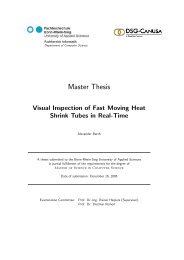Master Thesis - Hochschule Bonn-Rhein-Sieg
Master Thesis - Hochschule Bonn-Rhein-Sieg
Master Thesis - Hochschule Bonn-Rhein-Sieg
You also want an ePaper? Increase the reach of your titles
YUMPU automatically turns print PDFs into web optimized ePapers that Google loves.
5. Algorithms <strong>Master</strong> <strong>Thesis</strong> Björn Ostermann page 74 of 126<br />
The filter’s algorithm searches for pixels that are considered free. It then looks at the neighbouring<br />
pixels, to find intrusions. If an intrusion is found, it is compared to the minimum value in that pixel<br />
that was measured during the background acquisition (see chapter 5.2.1). If the value is greater than<br />
that minimum value, the pixel is considered as fluctuation noise and set to free space, since that value<br />
is likely to be caused by the background.<br />
The distance around free pixels, in which the algorithm searches for fluctuation noise can be<br />
configured.<br />
As Figure 51 shows, the search-area around free pixels, in which occupied pixels can be found and<br />
eliminated, can be larger than the one of the spike filter, which only searches in neighbouring pixels.<br />
The larger the search-area, the more pixels are checked that belong to intruding objects. This effect is<br />
compensated by the fact that this filter keeps values that are definite positives and eliminates only<br />
those of which are behind the minimal background distance. Although this filter may cause reduction<br />
in the size of objects, this only occurs with objects that are close to the background. The reduction<br />
must still be considered in the safety approval of the system (see chapter 6.3). This leads to far better<br />
results than the spike filter.<br />
a) b)<br />
free pixel found<br />
intrusion above minimal distance<br />
intrusion below minimal distance<br />
Figure 51: a) probability filter size 1, b) probability filter size 2<br />
Intrusion map, red = no intrusion, dark green = intrusion, light green = noise<br />
In this work only the smallest size of this filter, the search in neighbouring pixels, needed to be used,<br />
to attain sufficient results. The intrusion map, after application of this filter, is shown in Figure 52.














